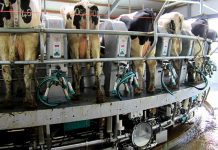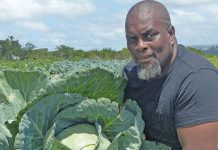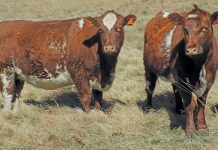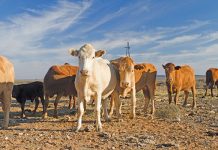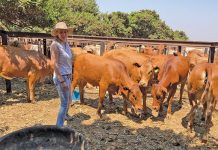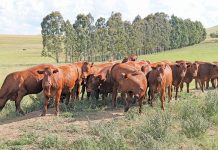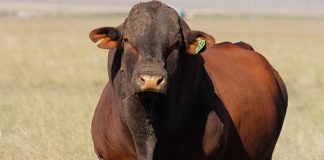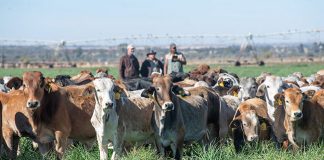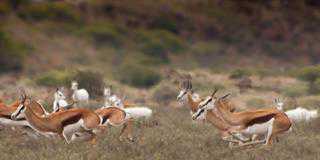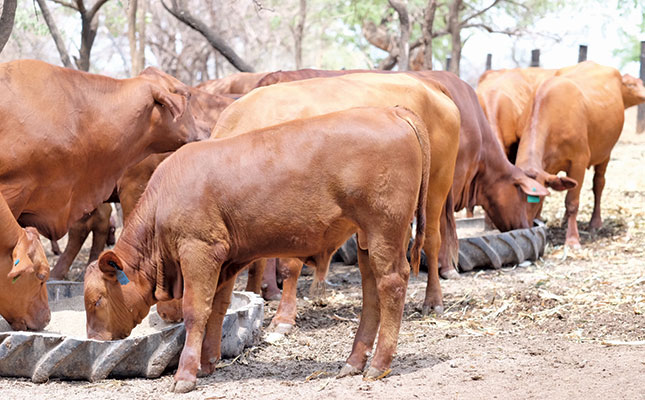
Photo: Peter Tselingas
Peter Tselingas readily admits to the biggest mistake in his farming career – not having started farming Brangus cattle long ago on his farm Pananyama Ranch in southern Malawi.
His aim as a stud breeder is to breed medium-framed, well-muscled cattle that are fertile, calve easily and are structurally sound. Peter tried various breeds but never really got the results he was looking for. Until, that is, his search led him to the Brangus breed.
“We contacted the Brangus Society of South Africa and were referred to South African Brangus breeder Dries Delport, from Boshof,” he recalls.
“As luck would have it, Dries was in Malawi at the time. He visited us on our farm and his great insight into the breed characteristics and his advice strengthened our decision to establish a Brangus herd. After the initial meeting with Dries, we imported 12 registered red Brangus cows in October 2014.”
Peter had previously bred Brahman crosses and liked the hardiness of the Brahman. He wanted a beef breed with high weaning weights, without sacrificing hardiness and adaptability, and Brangus ticked all the boxes for him.
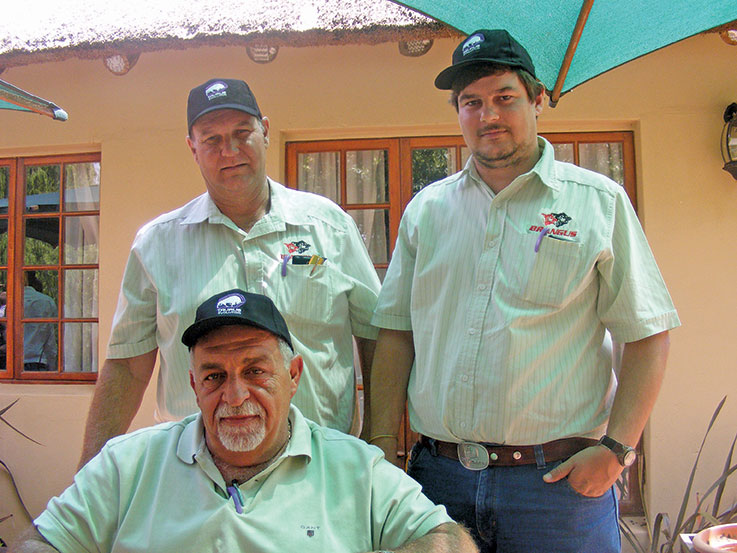
The breed was originally developed in the US to combine the superior traits of Angus and Brahman cattle. Genetic composition has been stabilised at 3/8 Brahman and 5/8 Angus, allowing breeders to combine the Brahman’s hardiness and adaptability with the Angus’s growth and even temperament.
Peter selected the red Brangus as red cattle are more competitively priced in the Southern African markets. The red Brangus gene pool is also larger than that of the black Brangus.
“Our goal is to build up a functional Brangus herd with fertile animals that will perform well for stud breeders as well as commercial cattlemen, whether in the feedlot or on the veld,” he explains.
Cattle, farm and veld
The Pananyama stud currently consists of 14 registered Brangus cows and 11 registered heifers. The commercial Brahman-type crossbred herd consists of 300 cows and 100 replacement heifers.
There are no bulls in the stud herd; cows are inseminated. The commercial herd uses Pananyama-bred Brangus bulls. Peter plans to expand the stud herd to 200 cows.
Peter and his family have farmed the 400ha Pananyama Ranch in the Chileka Region in southern Malawi since 1976. The dominant veld types are Savannah thornveld and Miombo woodland. Grasses include buffalo grass (Panicum maximum), fountain grass (Pennisetum setaceum) and Rhodes grass (Chloris gayana). Woodlands are dominated by broad-leaved deciduous Brachystegia. The soils are mainly clay loam.
Average annual rainfall is between 800mm and 1 000mm and the average temperature variation is between summer highs of 40°C and winter lows of 10°C.
The official carrying capacity is 4ha/MLU, but Peter stocks the farm at 2ha/MLU.
He provides supplementary feed in winter and Molatek’s Master 20 lick for pregnant females and bulls.
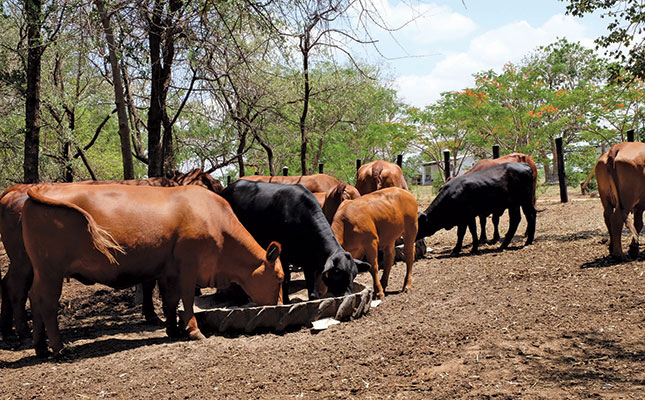
“We have an agreement with local small-scale maize farmers to supply cattle manure in return for all their crop residue, mainly maize stover,” he says.
The Tselinga’s land is divided into four camps with six watering points supplied by two boreholes and three catchment dams. A 65ha camp is used only in winter while the rest of the camps are about 5ha each. Cattle are rotated according to the condition of the veld, rather than to a set grazing programme.
The farm is running a project to establish Faidherbia albida (formerly Acacia albida) trees, a legume commonly known as the Ana tree in South Africa. It is widespread in the semi-arid areas of Africa in a range of soil types, climates and habitats. The leaves and pods provide nutritious and highly palatable fodder during the feed slump when few other sources of browse are available.
The UN’s Food and Agriculture Organisation (FAO) has calculated that the carrying capacity for cattle could be doubled on land planted to the Ana tree. During the hot season, the tree canopy provides valuable shade, and a mature tree provides up to 135kg of pods a year
Stud selection
After importing the first 12 registered Brangus animals from the Delport stud, Peter imported additional breeding stock from other South African studs, including Smith Brangus, Baumeister Brangus, Sleewyk Brangus Stud and BVN Brangus Stud. He also imported semen from Brazil and the US.
“I selected the genetic sources very carefully to ensure the genetic integrity of my stud,” he explains.
“I have learnt the hard way that if you don’t go for the best genetics from the start, you get throwbacks that delay the realisation of breeding goals.”
The Tselingases take pride in their stud bull Diesel SW09 30 from the BVN Brangus stud in South Africa. The bull stands at the Ramsem bull semen centre in Bloemfontein. He sired SW13 58, a South African Junior Champion Bull and the winner of a Gold Medal in the Africa/ Asia division of the 2015 Champion of the World online competition, where he competed against bulls and cows from six breeds in 66 countries.
The average Pananyama Brangus birth weight is 34kg. The imported South African cows averaged 460kg at weaning. The average weaning weight for bull and heifer calves was 242kg, which means that the cows weaned calves at 53% of their own weight. “One of our stud bull calves weighed 449kg at 400 days, while one of our heifers from the Hope bloodline weighed 302kg at 400 days,” says Peter.
Crossbreeding
He adds that Brangus performance in crossbreeding is impressive. Low birth weights largely eliminate calving difficulties while the outstanding growth of Brangus crosses at 200 and 400 days puts them at the top of most feedlot managers’ lists.
“The excellent fertility of the Brangus and the fact that it is naturally polled make it the obvious choice for crossbreeding,” he explains.
A local vet inseminates the Pananyama stud cows. Genetics from various bulls are selected and matched to traits of individual cows. The cows are synchronised for December/January breeding and calve down in September/October, just before the rainy season.
This means that the animals calve in time to take advantage of the fresh new veld grass. Peter’s mission is to grow the Brangus breed in Malawi. He aims to produce beef competitively and wants to contribute to sustainable and profitable red meat production in Malawi. “Red meat production here is a major challenge,” he explains. “We don’t get a price premium for A-grade beef on local markets.
The only buyers prepared to pay a premium are international supermarkets, hotels and high-class restaurants, but they usually import beef, mainly from South Africa.”
Contact Peter Tselingas at [email protected] or +265 99 982 5697.

